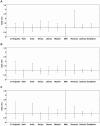No association between HIV and intimate partner violence among women in 10 developing countries
- PMID: 21170389
- PMCID: PMC2999537
- DOI: 10.1371/journal.pone.0014257
No association between HIV and intimate partner violence among women in 10 developing countries
Abstract
Background: Intimate Partner Violence (IPV) has been reported to be a determinant of women's risk for HIV. We examined the relationship between women's self-reported experiences of IPV in their most recent relationship and their laboratory-confirmed HIV serostatus in ten low- to middle-income countries.
Methodology/principal findings: Data for the study came from the most recent Demographic and Health Surveys conducted in Dominican Republic, Haiti, India, Kenya, Liberia, Malawi, Mali, Rwanda, Zambia and Zimbabwe. Each survey population was a cross-sectional sample of women aged 15-49 years. Information on IPV was obtained by a face-to-face interview with the mother with an 81.1% response rate; information on HIV serostatus was obtained from blood samples with an 85.3% response rate. Demographic and socioeconomic variables were considered as potentially confounding covariates. Logistic regression models accounting for multi-stage survey design were estimated individually for each country and as a pooled total with country fixed effects (n = 60,114). Country-specific adjusted odds ratios (OR) for physical or sexual IPV compared to neither ranged from 0.45 [95% confidence interval (CI): 0.23-0.90] in Haiti to 1.35 [95% CI: 0.95-1.90] in India; the pooled association was 1.03 [95% CI: 0.94-1.13]. Country-specific adjusted ORs for physical and sexual IPV compared to no sexual IPV ranged from 0.41 [95% CI: 0.12-1.36] in Haiti to 1.41 [95% CI: 0.26-7.77] in Mali; the pooled association was 1.05 [95% CI: 0.90-1.22].
Conclusions: IPV and HIV were not found to be consistently associated amongst ever-married women in national population samples in these lower income countries, suggesting that IPV is not consistently associated with HIV prevalence worldwide. More research is needed to understand the circumstances in which IPV and HIV are and are not associated with one another.
Conflict of interest statement
Figures

References
-
- Garcia-Moreno C, Watts C. Violence against women: its importance for HIV/AIDS. AIDS. 2000;14(Suppl 3):S253–265. - PubMed
-
- Martin SL, Curtis S. Gender-based violence and HIV/AIDS: recognising links and acting on evidence. Lancet. 2004;363:1410–1411. - PubMed
-
- WHO . Geneva: World Health Organization; 2004. Violence Against Women and HIV/AIDS: Critical Intersections (Intimate Partner Violence and HIV/AIDS).
-
- Andersson N, Cockcroft A, Shea B. Gender-based violence and HIV: relevance for HIV prevention in hyperendemic countries of southern Africa. AIDS. 2008;22(Suppl 4):S73–86. - PubMed
Publication types
MeSH terms
Grants and funding
LinkOut - more resources
Full Text Sources
Medical

